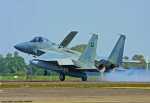Draft report released on Saudi air force plan

A draft document released by Air Force officials earlier this month formally named Mountain Home Air Force Base as the preferred location for a new foreign military training mission.
The initial environmental assessment produced by Air Combat Command headquarters in Virginia outlines a plan to station a Royal Saudi air force unit at the local base as part of a five-year agreement.
In December 2010, the Air Force named Mountain Home as the "preferred alternative" for this training squadron following a request made by Saudi officials. However, the agreement was still being finalized as part of an overall $60 billion arms package between both nations that was signed in late 2011.
The arms deal included the sale of 84 new F-15SA jets, upgrades to the Royal Saudi air force's existing fleet of 70 F-15s as well as munitions and spare parts.
According to the draft Air Force report, Mountain Home was identified as the only base capable of meeting the needs of this training unit. In short, the available options were limited to basing the unit here or taking no action to locate this training squadron in the United States.
The Saudi government had shown a strong interest in the base and sent several observer teams to analyze the installation's ability to handle this training squadron.
Similar in function to an F-15 training squadron from the Republic of Singapore already at the base, the Saudi unit would fly up to 18 F-15SA aircraft -- a modified version of the base's F-15E Strike Eagles.
"We are excited at the prospect of hosting another international partner here," said Col. Ron Buckley, 366th Fighter Wing commander, in a previous interview with the Mountain Home News. "For now, we will continue to build the exceptional relationship we have with the Republic of Singapore air force as we prepare together for the possibility of the Saudis becoming part of the Gunfighter community."
Led by U.S. Air Force officers, the training squadron would operate as a separate but integrated fighter unit under the operational control of the 366th Fighter Wing commander. A formal training unit for Saudi aircrews and maintenance teams, the plan would add 487 military and civilian contractors to the base to run the unit and provide necessary support services.
The total Royal Saudi air force contingent is expected to include 200 people, with a majority assigned here temporary as pilot training officers and maintenance trainees. Nearly 280 of the unit's manpower would include U.S. contractors.
Overall, the base's population is expected to increase 10 percent as a result of the beddown, according to the report.
To support the training unit, the base would need to build, modify or improve 22 facilities on base in previously developed areas. At a total estimated cost of $124 million, the Saudi government would reimburse expenses associated with these construction and upgrade projects. If everything remains on schedule, those projects would start in coming months.
Overall, airfield and flying operations at the base would increase by 34 percent when the training squadron activates, according to the report. However, the squadron would adhere to existing flight restrictions and avoidance procedures at the base and follow standard quiet hours.
The formal training unit and maintenance training center here seeks to maximize aircraft proficiency while minimizing cost and environmental impact, the report stated. In the past, the Saudi government has contracted a large part of its fighter jet maintenance but wants to develop a home-grown capability.
"(It) would help to meet the requirements of maintaining combat readiness with the RSAF to ensure that allied forces can perform as a team when needed," the report added. "The provision of such training has proven effective in maintaining combat readiness of allied forces and ensuring that allied forces can perform effectively in a multinational force structure when needed to fight as a team."
If plans stay on schedule, the squadron is expected to fly training missions here from 2014 to 2019, with an option to renew the agreement.
Following the full environmental assessment process, standard procedures would call for a Record of Decision to be issued. Most observers believe this would happen faster than unusual since much of this work was already done during studies on possibly basing F-22 and F-35 aircraft at the base.
An electronic version of the environmental assessment is available online at www.mountainhome.af.mil in the environmental information link. Public comments on the assessment are due by May 10.
People may send comments via e-mail at ACC.A7PP@langley.af.mil using the subject line "RSAF F-15SA review comments." They may also mail comments to the command headquarters using the following address: HQ ACC/A7PS, Attn: RSAF F-15SA review comments, 129 Andrews St., Suite 331, Langley AFB, VA 23665-2769.
